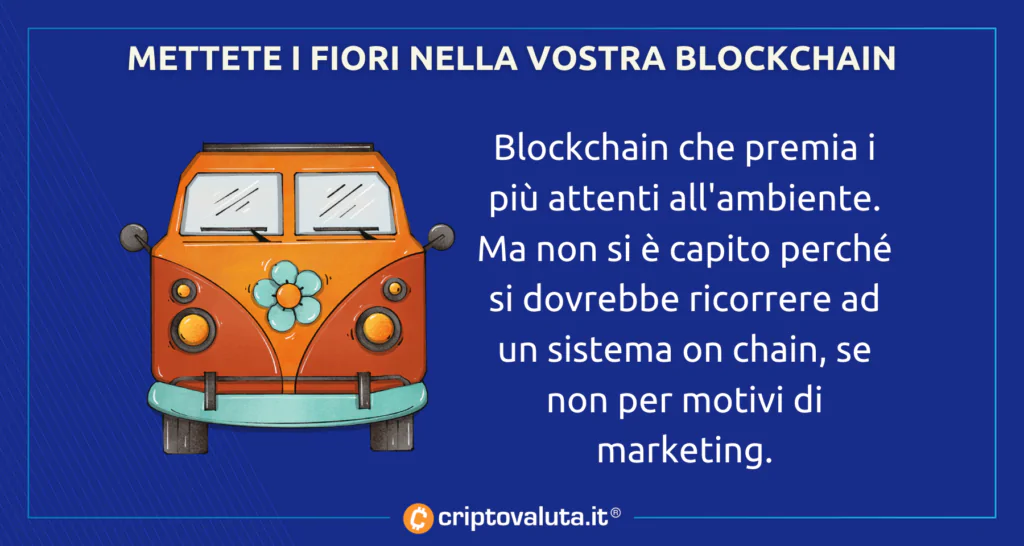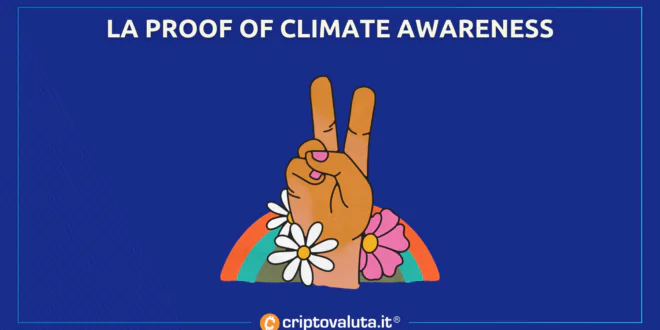SEB e Crédit Agricole hanno annunciato il lancio di so|bond, piattaforma per i bond digitali che utilizzerà tecnologie in blockchain e che ricorrerà ad un meccanismo di consenso decisamente curioso, che dovrà basarsi sulla sostenibilità e sull’impatto dei partecipanti.
Una piattaforma certamente curiosa – e che non mancherà di suscitare qualche risolino e il solito giro di polemiche – e che apre al sospetto che non si sia capito a fondo il perché del ricorso, da parte di Bitcoin alla Proof of Work. Ma tant’è e di questo dovremo parlare, dato che le società coinvolte sono del massimo grado di rilevanza in Europa.
E dato che l’impegno di soggetti di questo tipo si accompagnerà a tanti visto? Si poteva fare che senza alcun dubbio sentiremo arrivare, ancora una volta, da chi non ha capito granché dei meccanismi di consenso. Ma vediamo cosa si sono messi in mente questi due gruppi bancari e se la cosa avrà un senso oppure no.
Il protocollo Proof of Climate awaReness
Partiamo per le brevi. I due gruppi bancari avrebbero messo insieme un sistema in blockchain che dovrebbe venire utilizzato per scambiarsi bond (titoli di debito) tokenizzati. E fin qui nulla di strano, dato che diverse banche stanno lavorando in questo comparto e dato che ci sono state già emissioni di una certa importanza, anche da parte della Banca Europea degli Investimenti.

Il particolare non è appunto in cosa farà tale blockchain, ma in come lo farà. Il nome del protocollo è tutto un programma: Proof of Climate awaReness – o se preferite in italiano una Prova della Consapevolezza Climatica. Niente più macchine energivore che macinano hash, ma una prova di aver capito cosa sta succedendo al pianeta. Ok, e in che modo?
L’idea è quella di partire dalla Proof of Stake e, dicono loro, di migliorarla.
Nonostante la Proof of Stake utilizzi molta meno energia dei sistemi in Proof of Work, c’è spazio per ulteriori miglioramenti. La piattaforma so|bond è costruita su un nuovo modello di logica di validazione, la Proof of Climate awaReness. Permette un consumo di energia comparabile con quello dei sistemi non-blockchain e incentivi ai nodi che partecipano a migliorare costantemente l’impronta delle loro infrastrutture.
E se non è chiaro, hanno poi aggiunto:
Più specificatamente, ogni nodo sarà remunerato in accordo ad una formula legata al suo impatto climatico, che viene valutato secondo lo standard ISO Life Cycle Assessment: più basso è l’impatto ambientale, più alta sarà la ricompensa.
Almeno a leggerla fino a qui sembrerebbe però un sistema più per decidere chi incassa cosa delle commissioni di transazione, che per avere un sistema tramite il quale accordarsi per andare a risolvere… quanto i sistemi come Bitcoin provano a risolvere, ovvero il tenere un registro di transazioni comune, che non possa essere alterato da terzi e sul quale si è, in ultimo, d’accordo.
Operazione di marketing e greenwashing?
Non appena saranno disponibili i dati tecnici e magari avremo anche modo di accedere a tale chain potremo offrire una recensione più approfondita.
Sta di fatto che, per come è stata presentata, suona come un database (e infatti ne avrebbe anche i consumi) e sembrerebbe essere a tutti gli effetti un’operazione di marketing sfruttando uno dei vettori di attacco più comuni nei confronti di certi sistemi in blockchain.
Sistemi che, ad un certo livello, devono preoccuparsi di verificare che chi propone un blocco dica il vero, e non che abbia una gestione climate aware, e cioè attenta all’ambiente. Problema certamente importante, ma che con i meccanismi di consenso, da qualunque lato la si voglia guardare, c’entra poco o nulla.
A quanto ci è dato capire, per ora, si tratterebbe di una sorta di chain organizzata in stile Ripple e cioè con nodi per autorità – sulla quale è stato poi costruito un sistema di ricompense, che manca da Ripple stessa – che sarà tanto più conveniente per i partecipanti se questi saranno green fino al midollo. Iniziativa lodevole, magari. Ma che con la blockchain e con i problemi che prova a risolvere c’entra poco o nulla.
 Criptovaluta.it® Ultime Notizie Bitcoin e Crypto News | Criptovalute Oggi
Criptovaluta.it® Ultime Notizie Bitcoin e Crypto News | Criptovalute Oggi





Beh che dire: AHAHAHAAHAHAHAHAHAHAHAHAHAHAHAHAHAHAHAHAHAHAHAHAHAHAAHAHAHA
Surreale quanto alcune persone possano umiliarsi intellettualmente per compiacere certa politica.
Sarebbe stato un perfetto pesce d’aprile 3 giorni fa.
È come giocare a scacchi con un piccione.
Quello scagazza tutta la scacchiera ed alla fine ti dice “il mio re è in piedi, ho vinto.”
Verrebbe quasi la tentazione di fargli vedere che sappiamo fare stronzi molto più grossi.
Quasi.
Non curiamocene. Non siamo come loro.
:facepalm:
Bella questa. Ci sembra uno di quei signori un po’ in là con gli anni che credono basti dire “Ehi, come butta zio?!?!” per essere giovani.
Arrivano loro e fanno la blockcha*pardon* il database verde. Roba che SQLana in confronto è un gigante. Pffffffffffffffff
Lunga vita al Sommo Vitalik e al Protocollo. Ogni resistenza è futile. Sarete tutti un nostro layer2.
Hello,
i understand that without the details documentation of this new consensus you would not get the underlying principles. A Press release is meant to be short.
the whitepaper is available at https://github.com/ethereum-pocr/whitepaper/blob/main/whitepaper.md
nothing is perfect the first time but we ate keen to contributions.
Thank you mr. De Cadoudal. We will study the whitepaper and comment again on the matter ASAP!
And well, I think we got the underlying principles pretty well. We wrote that it looked like a Proof of Authority derivative 😉
Mister, you are doing a great mistake. Your chain can’t survive in the near future. Only the Protocol, Ethereum, will grow bigger and bigger. No future for other chains, like in the Sex Pistols song God Save the Queen (“noooo future, nooooo future for you[r chain]”, do you remember? Good)
So, call your IT team ASAP and tell them to make a layer2 on the Ethereum blockchain. It’s not too late. Believe us. We know it.
Long life to the High Vitalik and to the Protocol. Every resistance is futile. All of you will be one of our layers2.
A clarification: becoming our layer 2 will not make your chain better, or even useful for anything. But at least when you go out on Saturday night with friends you can brag and say “Hey Francoise, did you know that we are a layer2 of Ethereum? Cool, huh?!?”
Maybe the Supreme will even give you an autograph.
You are still in time. Think about it.
Long life to the Supreme Vitalik and to the Protocol. Every resistance is futile. All of you will be one of our layers2.
8.2 NodesA node willing to enter the consensus will need to make itself known to the community and get approved by more than half of the community of nodes.
A node entering the consensus will also need to be given a environmental footprint by one of the authorized auditors.[…]
Environmental footprint auditors have therefore a central role in the setup and must be carefully choosen by the community of the nodes. At the initialization, the banks will invite an initial single auditor to bootstrap the process.
The auditor will receive crypto units, precreated in the genesis block (including the necessary pledged amount – see below). With this the auditor will enroll itself as the first auditor in the PoCR governance smart contract initializing at the same time the mechanism for enlisting and excluding auditors.
Are you kidding?!? This is not a blockchain. Do you know where those “authorized auditors” can go? We have a couple of ideas. Sharing them could be suitable for a ban, so we won’t do it. But probably you understand what we mean.
1/10, very bad attempt.
Try again.
Long life to the Supreme Vitalik and to the Protocol. Every resistance is futile. All of you will be one of our layers2